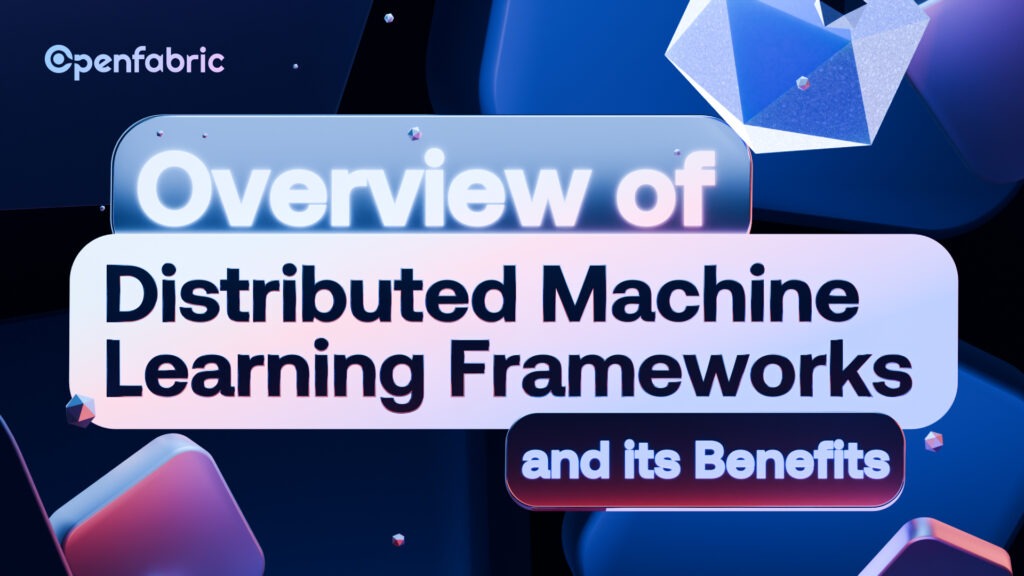
July 4, 2025 5 minutes read
Overview of Distributed Machine Learning Frameworks and its Benefits

Building a house can either be one person’s job or can be done by multiple people. The difference is, that the former is time-demanding, stressful, and generally slower. However, when multiple people are handling different aspects of the project the final result is achieved in a short amount of time and is less demanding on the parties involved. This is how distributed machine learning frameworks operate.
Since time immemorial, Artificial Intelligence has always required a large amount of data to function. This need has not diminished with advanced technologies. Rather, as modern AI solutions improve in their accuracy, they require more amounts of data. This expansion presented a new challenge. The volume of data, coupled with the complexity of the AI models, makes it impractical for a single machine to train these models and still provide real-time insights.
What is the solution? Developers found a way to distribute the burden of a single machine into smaller ones. Then, they distributed these machine learning tasks, such as training models, across multiple machines so that even with the vast amount of data and tasks, AI can still provide accurate results with real-time insights. In this article, we will see what these frameworks are and why they may be regarded as game-changers in the industry.
Let’s get started!
What are distributed machine learning frameworks?
Distributed machine learning frameworks are tools that are used in distributed machine learning to train and deploy machine learning models. These frameworks often use computing nodes like CPUs and GPUs, or servers that make handling and analyzing massive amounts of data possible. The computational workload is divided among a number of agents, and this enables quicker and more effective data processing and integration into a machine learning model.
Each framework has a small portion of the vast amount of data, analyses it concurrently, and integrates the outcome into a final output, a machine learning model. By doing so, the burden is not on a single machine.
Popular examples of distributed learning frameworks include; TensorFlow, Apache Spark MLlib, PyTorch, Horovod, and so on.
How do they work?
At the earlier stages of AI development, the processing power of the machine learning model could be improved by upscaling the computer. Upscaling the computer could be done by increasing the number of cores, the amount of memory, and so on. But then the data kept growing, and so did the data needed to train the AI models and so these conventional methods were no longer sufficient.
The conventional methods of upscaling and training machine learning models have since been replaced and distributed machine learning frameworks are now used to handle the massive amount of data for training AI models. Essentially, these frameworks in distributed machine learning use parallel processing techniques for distributed machine learning and here is a simple view of how it works:
- Data segmentation and partitioning: First of all, the data is split into smaller parts or units based on the number, size, and type of the available servers.
- Model parallelism: Next, each processor starts working on its parts individually, without other processors or servers. It is called parallelism because the different parts of a model are being trained simultaneously.
- Synchronization: the processors do not operate blind; they communicate with each other to ensure that the whole process is consistent within the system.
- Summation of the result: after all the processors have carried out their tasks, all the results are joined together to produce the final result; a trained machine learning model or model segment.
Benefits of distributed machine learning
Scalability
Early single machines struggled as growing data volumes overwhelmed their memory and processing power. Distributed machine learning frameworks allow for models to be trained using massive datasets or hyperparameters that are spread across nodes. This accommodates the growth of data which has great prospects of improving the accuracy of machine learning models in the future.
Faster time for training
Consider one person building a house versus many people working together to build it faster. We can agree that the construction would take a much shorter time when several people handle the task. This is the same with distributed machine learning frameworks.
In this case, training that would take days on a single GPU can now be done in hours or minutes. The competition in the industry and the growing need for specific AI models make this ideal for developers. This allows developers to quickly train, test, and deploy AI models for end-user use if performance is satisfactory.
Cost efficient
Time, as they say, is money. Therefore, the time saved from using distributed machine learning platforms helps developers save money. In some instances, this might not be literal. Despite GPU and data costs, distributed machine learning trains and deploys models quickly, making it cost-efficient for developers.
Elimination of single-point failures
Distributed machine learning trains models using multiple computers, each processing a portion of the data independently. A fault in one processor doesn’t affect the entire system, unlike failures in single-machine setups.
Furthermore, these faults in one of the processors can be easily identified and corrected. As opposed to single machines, where finding a fault in the system is like looking for a needle in a haystack.
Read how to tune hyperparameters!
It supports complex AI models.
Complex AI models require a considerable amount of data. A data size so large that single machines cannot handle it. Splitting data across computers allows each part of a complex AI model to be processed and combined into a whole. Distributed machine learning makes it possible to train and fine-tune complex, large-scale AI models effectively.
Encourages collaboration
Earlier, we noted that model parallelism is where multiple computers or processors work on different parts of the data individually and simultaneously. This working process encourages team collaboration and allows developers to experiment with the AI models without compromising the whole structure. By adjusting or improving a processor, different outcomes of a particular AI model can be achieved. This is crucial in exploring the applications of AI models in fields such as health care and scientific research.
Conclusion
Distributed machine learning frameworks support distributed computation or machine learning. It is critical for training large-scale and complex models on large datasets. These frameworks use distributed ML to split data into chunks processed simultaneously by multiple computers. Distributed machine learning supports AI’s growth by handling complex models and large data efficiently across multiple systems.

